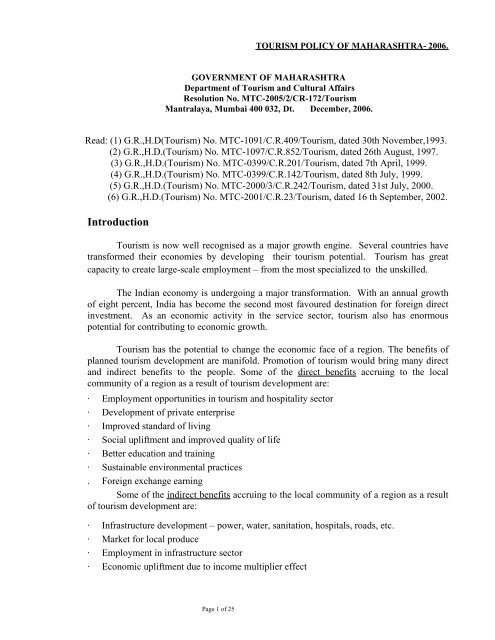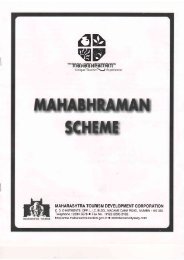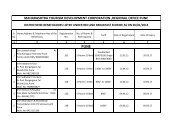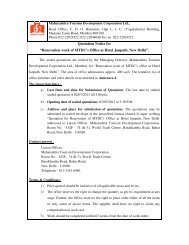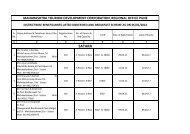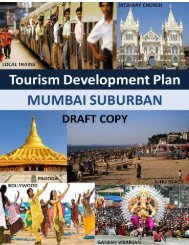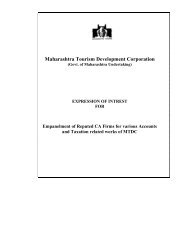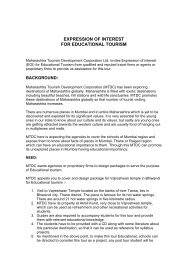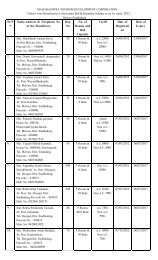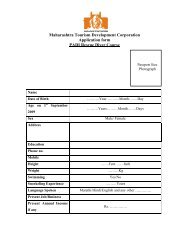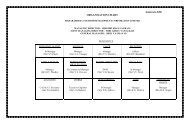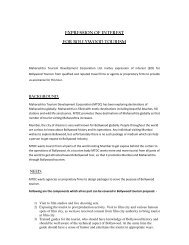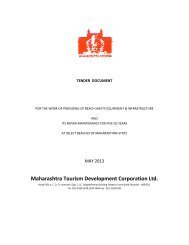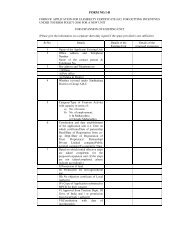Maharashtra Tourism Policy-2006
Maharashtra Tourism Policy-2006
Maharashtra Tourism Policy-2006
Create successful ePaper yourself
Turn your PDF publications into a flip-book with our unique Google optimized e-Paper software.
TOURISM POLICY OF MAHARASHTRA- <strong>2006</strong>.<br />
GOVERNMENT OF MAHARASHTRA<br />
Department of <strong>Tourism</strong> and Cultural Affairs<br />
Resolution No. MTC-2005/2/CR-172/<strong>Tourism</strong><br />
Mantralaya, Mumbai 400 032, Dt. December, <strong>2006</strong>.<br />
Read: (1) G.R.,H.D(<strong>Tourism</strong>) No. MTC-1091/C.R.409/<strong>Tourism</strong>, dated 30th November,1993.<br />
(2) G.R.,H.D.(<strong>Tourism</strong>) No. MTC-1097/C.R.852/<strong>Tourism</strong>, dated 26th August, 1997.<br />
(3) G.R.,H.D.(<strong>Tourism</strong>) No. MTC-0399/C.R.201/<strong>Tourism</strong>, dated 7th April, 1999.<br />
(4) G.R.,H.D.(<strong>Tourism</strong>) No. MTC-0399/C.R.142/<strong>Tourism</strong>, dated 8th July, 1999.<br />
(5) G.R.,H.D.(<strong>Tourism</strong>) No. MTC-2000/3/C.R.242/<strong>Tourism</strong>, dated 31st July, 2000.<br />
(6) G.R.,H.D.(<strong>Tourism</strong>) No. MTC-2001/C.R.23/<strong>Tourism</strong>, dated 16 th September, 2002.<br />
Introduction<br />
<strong>Tourism</strong> is now well recognised as a major growth engine. Several countries have<br />
transformed their economies by developing their tourism potential. <strong>Tourism</strong> has great<br />
capacity to create large-scale employment – from the most specialized to the unskilled.<br />
The Indian economy is undergoing a major transformation. With an annual growth<br />
of eight percent, India has become the second most favoured destination for foreign direct<br />
investment. As an economic activity in the service sector, tourism also has enormous<br />
potential for contributing to economic growth.<br />
<strong>Tourism</strong> has the potential to change the economic face of a region. The benefits of<br />
planned tourism development are manifold. Promotion of tourism would bring many direct<br />
and indirect benefits to the people. Some of the direct benefits accruing to the local<br />
community of a region as a result of tourism development are:<br />
· Employment opportunities in tourism and hospitality sector<br />
· Development of private enterprise<br />
· Improved standard of living<br />
· Social upliftment and improved quality of life<br />
· Better education and training<br />
· Sustainable environmental practices<br />
. Foreign exchange earning<br />
Some of the indirect benefits accruing to the local community of a region as a result<br />
of tourism development are:<br />
· Infrastructure development – power, water, sanitation, hospitals, roads, etc.<br />
· Market for local produce<br />
· Employment in infrastructure sector<br />
· Economic upliftment due to income multiplier effect<br />
Page 1 of 25
<strong>Tourism</strong> Potential in <strong>Maharashtra</strong><br />
<strong>Maharashtra</strong> is the third largest State of India, both in area and population. It is<br />
located on the West Coast of India with a 720 km long coastline along the lush green<br />
Konkan region. Nestled in the Western Ghats and the Sahyadri mountain range are several<br />
hill stations and water reservoirs with semi-evergreen and deciduous forests. The Vidarbha<br />
region of <strong>Maharashtra</strong>, with its dense forests, is home to several wild life sanctuaries and<br />
nature parks. Thus all the three regions of <strong>Maharashtra</strong> offer considerable tourism potential.<br />
<strong>Maharashtra</strong> abounds in numerous tourist attractions ranging from ancient cave<br />
temples, unspoiled beaches, ancient forts and monuments, forests and wildlife, unique hill<br />
stations, pilgrimage centres, and a rich tradition of festivals, art and culture. Hence our<br />
campaign slogan for <strong>Maharashtra</strong> <strong>Tourism</strong> – “MAHARASHTRA UNLIMITED!”<br />
<strong>Tourism</strong> trends<br />
India: The growth of tourism in India, has been rapid in the last five years despite a late<br />
start. Tourist arrivals have gone up by more than 25% and foreign exchange earnings has<br />
jumped by 40%. The World Travel & <strong>Tourism</strong> Council has rated India as one of the five<br />
fastest growing tourism economies in the world. The survey conducted by “Lonely Planet”<br />
has also supported this view. The rich heritage, trade, culture, history and growing economy<br />
have become major attractions for the tourists. The survey conducted by “Conde Nast<br />
Traveller” came out with the finding that India is preferred to many other tourist<br />
destinations like France, Singapore and Switzerland.<br />
<strong>Maharashtra</strong>: The domestic tourists visiting <strong>Maharashtra</strong> doubled during the last decade,<br />
from 41.29 lakhs in 1991 to 84.8 lakhs in 2001, whereas the number of foreign tourists<br />
visiting Mumbai increased from 7 million in 1991 to 8 million in 2001.<br />
The rapid growth in domestic tourism can be attributed to the ever increasing middle<br />
class, increase in disposable income, improved facilities, stress on urban families, improved<br />
connectivity to tourist destinations, etc. Not all foreign tourists visiting Mumbai visit<br />
<strong>Maharashtra</strong>. Some of these foreign tourists come to Mumbai as an entry point to India and<br />
proceed to various other states. There is need and scope to attract these visitors into<br />
<strong>Maharashtra</strong> to the various tourist destinations in our State.<br />
Action Plan for the Next Five Years.<br />
The following action plan will be implemented in the next five years to achieve the<br />
above objectives and the long-term vision for 2025.<br />
1. Development of infrastructure at tourist destinations : Various tourism facilities<br />
such as accommodation facilities, eateries, toilets, information centres, etc. would be<br />
developed at all destinations. For this, the incentive policy proposed will encourage private<br />
partnership in tourism related activities and infrastructure development. Access to weekend<br />
destinations (hill-stations, beaches, etc.) near major cities in <strong>Maharashtra</strong> would be given<br />
preference.<br />
2. Accessibility to tourism destinations and wayside amenities : Approach roads<br />
would be identified to various tourist destinations in <strong>Maharashtra</strong>. The roads would be<br />
Page 2 of 25
assessed for suitability (carrying capacity, quality, etc.) and would be considered for further<br />
development. Wayside amenities would also be planned while developing roads.<br />
In addition, rail linkages and air connectivity to important tourism destination must<br />
be strengthened by co-ordination with the concerned departments and Ministries.<br />
3. Development Control Regulation at destinations:‘Development Control<br />
Regulations’ would be prepared to work as guidelines for development at and around<br />
important tourism destinations/ areas.<br />
4. Strengthening of Bed and Breakfast scheme : The Bed and Breakfast scheme creates<br />
facilities for travellers at remote destinations (where hotel accomodation is not available) and<br />
provides income to the local people. With the increasing interest in the rural way of life and the<br />
advent of rural tourism, the Bed and Breakfast Scheme offers excellent potential for the mutual<br />
benefit of tourists and the local population. This Scheme will be strengthened to form a part of rural<br />
micro-financing projects.<br />
5. Recreational facilities at destinations: Entertainment facilities such as children's<br />
sports, horse rides, light and sound shows (based on feasibility) will be arranged at selected<br />
destinations. Providing recreation and entertainment at tourism destinations can convert day<br />
tourists into staying tourists.<br />
6. Public-Private-Partnership: Specific destinations and monuments would be<br />
identified where public-private partnership is possible. Conservation plans would be<br />
prepared for the identified monuments. The concept of Public Private partnership would<br />
also be applied to the development of resorts at select destinations and for the organisation<br />
of festivals.<br />
7. World Heritage Sites: Conservation and tourism development of three heritage<br />
sites (Ajanta, Ellora and Elephanta) are covered under external funding. Special attention<br />
will be given to the newly declared site - Chatrapati Shivaji Terminus. A detailed<br />
conservation and tourism plan will be prepared to showcase it as one of Mumbai’s tourist<br />
attractions.<br />
Other monuments that are suitable to be promoted as world heritage sites would be<br />
identified in coordination with the concerned agencies such as ASI, State Directorate of<br />
Archaeology, etc.<br />
8. Cultural <strong>Tourism</strong>: Distinctive aspects of <strong>Maharashtra</strong>’s rich culture and tradition<br />
would be identified and promoted as an integral part of <strong>Maharashtra</strong>'s tourism.<br />
Identify and promote the State’s folk arts and organize folk dance and music<br />
programmes at tourist destinations<br />
- State government would identify the artistes in the state and the details (name,<br />
art/dance type, contact details, etc.) of these artistes would be recorded in the tourism<br />
portal.<br />
- Register the artist or his/her group.<br />
- Arrange cultural programmes at MTDC resorts/ destinations involving local art<br />
forms.<br />
Page 3 of 25
- Prepare and organise a calendar of festivals specially focused to attract tourists.<br />
- Local cuisine would be identified and promoted at MTDC resorts. Food festivals<br />
showcasing various types of Maharashtrian cuisine would be organised.<br />
- Identify local melas/festivals that have been traditionally held for many years to<br />
showcase these traditions.<br />
9. Crafts: Since <strong>Maharashtra</strong> has a number of exclusive handicrafts; the government<br />
would undertake the following activities to promote the handicrafts industry in the state:<br />
- Appoint a design agency to develop products based on local crafts.<br />
- Based on their recommendation, training will be arranged for artisans to develop<br />
various products.<br />
- Develop and promote the State’s handicrafts industry through e-commerce.<br />
- Handicraft artisans of various crafts would be identified. Quality of the products<br />
would be standardized and products would be marketed through e-commerce.<br />
- On-line /e-commerce application would be developed and backward linkages would<br />
be established with the artisans.<br />
- Simultaneously, marketing support in terms of providing common sale outlets like<br />
bazaars and haats would be provided for handicraft products.<br />
10. Pilgrimage Circuits : <strong>Maharashtra</strong> is known for its pilgrimage centers like the<br />
Jyotirlingas, the Ashta Vinayaks and other famous temples at Shirdi, Pandarpur, Kolhapur,<br />
etc. Pilgrim circuits can be developed, connecting these pilgrimages.<br />
Maintaining sanctity and cleanliness at the place of pilgrimage is of utmost<br />
importance to provide an enhanced experience and attract more tourists. The responsibility<br />
for development of pilgrimage centres has been entrusted to the Urban Development<br />
Department or Rural Development Department vide G.R. No. MIS<br />
7896/1830/CR-78/96/UD-18 dated 17th May, 1996. <strong>Maharashtra</strong> tourism would assist the<br />
Urban Development Department and Rural Development Department for preparing a<br />
development model which can be applied to all pilgrimage sites. However, the nodal<br />
department will be the Urban Development Department / Rural Development Department.<br />
11. Rural <strong>Tourism</strong> : Rural <strong>Tourism</strong>, Agricultural <strong>Tourism</strong> & Wine <strong>Tourism</strong> will be<br />
promted considering state potential & varieties existing in our state.<br />
12. Fort /Fort Circuits : <strong>Maharashtra</strong> has a large number of forts which are valued not<br />
only for their historical significance but also for their architectural excellence. The<br />
Government of <strong>Maharashtra</strong> in coordination with ASI and State Archeology, develop and<br />
conserve these forts for realizing their tourism potential.<br />
13. Application of Information Technology for tourism : Effective utilisation of the<br />
website/portal for tourism promotion of <strong>Maharashtra</strong> in India and abroad would be ensured.<br />
Online advertising material would be prepared by MTDC and posted on the portal. Online<br />
bookings for the Deccan Odyssey as well as for all MTDC resorts will be operationalised .<br />
Page 4 of 25
14. Information Kiosks : Government of <strong>Maharashtra</strong> would create kiosks at important<br />
airports, railway stations, bus stations and important public places to provide tourism<br />
information on an interactive basis with links to the tourism portal and on-line booking<br />
systems.<br />
15. Creating Awareness : Create awareness among people about the importance of<br />
tourism, how to identify and plan tour options and on how to be an enlightened tourist. This<br />
would also include creating awareness about safety and environmental awareness.<br />
16. Safety & Security : The <strong>Tourism</strong> Department will formulate the guidelines for the<br />
safety of tourists on the beaches of State as well as the those tourists venturing into water<br />
sports activities.<br />
17. Training and Capacity Building : Carry out training needs assessment for tourism<br />
staff and plan for training programmes, with a view to capacity building of all partners and<br />
stake holders in the tourism sector. This will be in co-ordination with the "Atithi Devo<br />
Bhava" programme of the Central Government.<br />
18. Coordination and Monitoring : State Government would form a committee<br />
involving the Department of <strong>Tourism</strong>, MTDC, and other related departments to play a<br />
coordinating role. This committee would also identify developmental needs (either<br />
infrastructure or site facilities) at various destinations.<br />
Special Task Forces would be created for the following activities:<br />
Public-private-partnership, arts and crafts, pilgrimage tourism, Development Control<br />
Regulations at destinations.<br />
19. Organisational Review : A thorough review of institutional and staffing<br />
requirements of the Department of <strong>Tourism</strong> and MTDC would be taken up for restructuring<br />
the roles and functions of departments/individuals, based on the needs of tourism<br />
development in the State.<br />
20. Nodal Office in New Delhi : A nodal office in New Delhi will focus on marketing<br />
for the Deccan Odessey and bookings for <strong>Maharashtra</strong> <strong>Tourism</strong> and MTDC resorts apart<br />
from liaisoning with other departments and agencies and handling promotional activities.<br />
21. Single window clearance system: The Government will create a system for single<br />
window clearance for facilitating tourist projects in consultation with all concerned<br />
departments.<br />
22. Tourist Survey Statistics: Periodic tourism statistics are not readily available in<br />
<strong>Maharashtra</strong>. A mechanism would be developed to collect tourism statistics in the State.<br />
Availability of periodic statistics will help in analysis and deriving recommendations for<br />
better tourism management. Certain statistics are available through sale of tickets. To get<br />
complete statistics, MTDC would<br />
- tie up with various tourism related institutes such as ASI, State Directorate of<br />
Archaeology, hotels near destinations, tour operators, etc. to get statistical<br />
information on tourist arrivals<br />
- develop information requirement formats and send to the above agencies<br />
Page 5 of 25
- develop a computerised database to store and analyse the data collected<br />
- collect monthly data/information<br />
- conduct periodic (may be yearly/once in two years, etc.) tourist surveys and impact<br />
analysis.<br />
23. Evaluation and outcome budgetting : From the financial year 2005-06,<br />
Government of <strong>Maharashtra</strong> has initiated the process of evaluating each department by the<br />
outcome of their schemes. The emphasis has shifted from merely spending funds to the<br />
actual utility and out comes of the funds spent. Accordingly, parameters would be identified<br />
and reviewed such as tourist arrivals, increase in employment generation, district (area)<br />
domestic products etc. Studies would be regularly held either through Government<br />
departments or Universities, Colleges and private agencies to assess the impacts and<br />
outcomes of tourism projects on a sample basis. Also, feasibility studies would preferably<br />
be undertaken before embarking on tourism projects where huge investment is required so<br />
that unfruitful expenditure can be avoided.<br />
1. TITLE :-<br />
RESOLUTION<br />
This scheme will be known as “THE TOURISM POLICY-<strong>2006</strong>”<br />
2. PERIOD OF OPERATION :-<br />
This scheme comes into operation with effect from the 1st November, <strong>2006</strong> and shall<br />
remain in force for a period of ten years or until substituted by a new package scheme of<br />
incentives.<br />
3. COVERAGE :-<br />
Coverage under the <strong>Tourism</strong> <strong>Policy</strong>-<strong>2006</strong> – <strong>Tourism</strong> Projects in the Private Sector,<br />
State Public Sector/Joint Sector and the Co-operative Sector but not in the Central Public<br />
Sector will be considered for the incentives under “The <strong>Tourism</strong> <strong>Policy</strong>-<strong>2006</strong>”. The<br />
proposed tourist facilities shall be open to all and shall not be confined to the exclusive use<br />
of any particular individual or members of any group or club or have any such other<br />
restrictions.<br />
4. ELIGIBLE UNITS :-<br />
1) Hotels, Heritage Hotels, Resorts and Health Farms, Health & Wellness spa<br />
and units registered under the Bed and Breakfast scheme of MTDC.<br />
2) Motels and wayside amenities,<br />
3) Apartment Hotels/Service Apartments,<br />
4) Water Sports and Amusement Parks,<br />
5) Arts and Crafts Villages,<br />
6) Golf Courses,<br />
Page 6 of 25
7) Camping, Caravaning and Tent Facilities,<br />
8) Arial Ropeways,<br />
9) Convention Centres,<br />
10) Development of Hill Stations,<br />
11) Adventure <strong>Tourism</strong> Projects<br />
12) Houseboats<br />
13) Eco-<strong>Tourism</strong> Projects.<br />
14) Museums and Aquariums.<br />
15) Projects approved by classification Committee of the<br />
5. DEFINITIONS<br />
<strong>Tourism</strong> Department of the State Government or Govt. of India.<br />
5.1 <strong>Tourism</strong> Undertaking<br />
“<strong>Tourism</strong> Undertaking” means a legal entity in the form of a registered company<br />
under the Companies Act, 1956, or a partnership firm, a Registered Trust or a legally<br />
registered co-operative society or an individual proprietary concern, engaged in or to be<br />
engaged in one or more tourism projects.<br />
5.2 New <strong>Tourism</strong> Unit<br />
A “New <strong>Tourism</strong> Unit” means a new tourism project set up for the first time by a<br />
tourism undertaking satisfying the following conditions :-<br />
(a) the new project should have obtained a registration with the registering<br />
authority, as may be required after this policy comes into force.<br />
(b) the new project should have separately identifiable capital investment and it<br />
should not be an expansion of the existing project except as provided in “c”<br />
below.<br />
(c) expansion of an existing project will also be eligible for the incentives under this<br />
scheme provided that the existing tourism unit increases its investment in either<br />
its fixed capital, or capacity by at least 50% of the gross fixed capital and<br />
capacity at the end of the last financial year.<br />
5.3 Eligible Capital Investment<br />
The term "eligible capital investment" means investment in capital assets acquired<br />
and paid for & shall include investment in:-<br />
i) Land/area in effective possession with legitimate legal rights as per the<br />
requirement of the project.<br />
ii) Building i.e. any built-up area used for the eligible unit including administrative<br />
building, residential quarters, and accommodation for all such facilities as required for<br />
the running of the unit.<br />
Page 7 of 25
iii)<br />
iv)<br />
Plant and Machinery, Amusement rides/games, Air-conditioning equipments<br />
and other equipments including Water Sports equipments, Tents, other<br />
equipment as are necessarily required and exclusively used for sustaining the<br />
working of the eligible unit but will not include vehicles, furniture and<br />
fixtures, cutlery, crockery and utensils.<br />
The cost of development of the site of the location of the eligible unit, such as<br />
fencing, construction of internal roads, landscaping and other infrastructural<br />
facilities which the eligible unit has to incur under the project.<br />
v) Existing hotels which have not got any incentives either from SICOM or<br />
MTDC in the past, will be encouraged to convert themselves into at least<br />
three star category hotels by offering them incentives for a period of 3 years<br />
only, limited to 75% of their eligible Fixed Capital Investment [Gross block<br />
as on 31 st March 2007].<br />
vi)<br />
vii)<br />
viii)<br />
ix)<br />
5.4. Not Eligible<br />
Consultancy charges/feasibility report charges (not more than 2% of total<br />
project cost)<br />
Installation charges.<br />
The amount paid as non-refundable interest-free deposit to the electricity<br />
service provider or other Power Supply Company for supply of power to the<br />
eligible unit or to any other agency for similar purpose.<br />
Above investment should be made by an eligible unit during the operative<br />
period of the scheme. Investment prior to or subsequent to the operative<br />
period will not be eligible for incentives.<br />
The following investment shall not be eligible for incentives viz. (1) Working<br />
Capital, (2) Goodwill, (3) Preoperative expenses, (4) Second-hand plant and<br />
machinery purchased or shifted from within the country, (5) Interest capitalized, (6)<br />
Trucks, cars, vans, trailers, tractors and transport vehicles except approved<br />
sight-seeing buses operating in Municipal Corporation areas which are registered as<br />
such and approved by the concerned transport authorities.<br />
5.4(1) Any investment in any asset, which has a life span of less than five years, except<br />
Tents.<br />
5.4(2) Eligibility period - means the period of 3 years (or 5 years in case extension is<br />
granted) with effect from the date of eligibility certificate or such lesser period as<br />
may be prescribed, provided that the last date shall not fall after completion of the<br />
operative period.<br />
6. CLASSIFICATION OF AREAS<br />
For the purpose of administration of the incentive scheme under the <strong>Tourism</strong> <strong>Policy</strong>,<br />
<strong>2006</strong>, the State has been divided into three zone A, B, and C as shown in Annexure-B.<br />
7. EFFECTIVE STEPS<br />
The effective steps shall comprise of (a) initial and (b) final steps :<br />
Page 8 of 25
(a) Initial effective steps will include :<br />
i) Effective possession of land by an eligible unit free from all encumbrances and<br />
with legitimate legal rights.<br />
ii) Registration in respect of company/co-operative society/Trust with the respective<br />
registering authority. In respect of partnership firm, evidence of execution of a<br />
partnership deed and requisite application with the payment of necessary registration<br />
fees with the Registrar of firms.<br />
iii) Submission of project report specifically mentioning the category of tourism<br />
activity (coverage) and the incentives that are proposed to be availed of by the<br />
eligible unit with all relevant details.<br />
iv) Copy of permissions from all concerned statutory and executive authorities from<br />
whom permission is required under various laws.<br />
v) Registration with the respective authority.<br />
(b) The final effective steps shall mean and include :<br />
i) Clearances, if any, from Central/State Government and other concerned authorities<br />
for implementing the project.<br />
ii) Arranging of finance for the project to the satisfaction of the incentivessanctioning<br />
authority.<br />
iii) Acquisition of fixed assets at site to the extent of 10% of the total fixed assets as<br />
envisaged for the project, and<br />
iv) Evidence regarding expenditure on the project, including advances and<br />
pre-operative expenses paid, aggregating to at least 25 percent of the capital cost<br />
envisaged for the project.<br />
8. IMPLEMENTING AGENCY<br />
For the purpose of registration and claiming of incentives under the package scheme,<br />
the <strong>Maharashtra</strong> <strong>Tourism</strong> Development Corporation Ltd. (MTDC) is notified as the<br />
Registering Authority.<br />
The tourism unit after taking initial effective steps, shall apply to the MTDC for<br />
registration for incentives in the prescribed form.<br />
MTDC shall charge a service charge for processing the application as approved by<br />
the State Government.<br />
9. ELIGIBLE UNITS<br />
The unit falling in areas as classified /defined in Annexure ‘B’ in A, B, & C zones,<br />
for being eligible for the incentives under the new scheme of incentives in the<br />
<strong>Tourism</strong> <strong>Policy</strong> <strong>2006</strong>, should have a minimum fixed capital investment of Rs. 100<br />
lakhs or more, Rs. 50 lakhs, and Rs. 25 lakhs respectively which should be made<br />
within 3 years, 2 years and 18 months respectively from the date of registration.<br />
10. FISCAL INCENTIVES<br />
Tax exemption will be available to new units and expansion of existing units (as per<br />
the conditions set out earlier) in respect of the following taxes, up to 100% of capital<br />
investment or completion of the eligible period of 5, 7 or 10 years, whichever is<br />
earlier. The tax exemption will be available to eligible units conforming to the list in<br />
Annexure ‘B’ and falling within the eligible areas for a period of 5, 7 & 10 years<br />
Page 9 of 25
(a)<br />
respectively for A, B and C areas as shown in Annexure ‘B’ subject to the<br />
conditions hereinafter.<br />
The certificate of Entitlement & the eligibility certificiate shall automatically stand cancelled<br />
on completion of the above period or the limit prescribed for eligible investment.<br />
List of taxes<br />
1) Total exemption from Luxury Tax (as applicable to Hotels) for a period of 7 &<br />
10 years depending on the location of the tourism project in the B and C zones<br />
respectively & 50% exemption for a period of 5 years in A zone.<br />
2) Total exemption from Entertainment Tax/Amusement Tax for a period of 5, 7<br />
and 10 years depending on the location of the tourism project in the A, B, and C<br />
zones respectively.<br />
3) Total exemption from Stamp Duty for the projects located in B and C zones and<br />
50% exemption from stamp duty for projects located in A zone.<br />
(b)<br />
Electricity concessions<br />
Electricity duty will be levied at industrial rates for the respective period.<br />
(c)<br />
Other Concessions:<br />
(1) 75% exemption from registration charges and 50% concession from payment of<br />
permit charges for sightseeing buses registered as such and approved by the transport<br />
authority, having minimum seating capacity of 25 seats and operating in Municipal<br />
Corporation areas and hill stations.<br />
(2) Total exemption from Property Tax & Non-Agricutural Tax to all tourism projects<br />
run/owned/ by MTDC.<br />
(3) The water rate/ tariff, shall be levied at maximum Industrial Rate.<br />
(4) Property Tax shall be charged at Residential Rate.<br />
( d ) NDZs : Many tourism areas can attract a number of foreign as well as domestic<br />
tourists provided suitable areas/plots can be offered to such projects. As Govt. has allowed<br />
IT activities in No Development Zones (NDZ), tourism activities such as entertainment<br />
centres which include small golfing facilities, tourism villages, handicraft displays with no<br />
extra FSI should also be considered in the NDZ.<br />
(e) Renewal of Licences :<strong>Tourism</strong> projects require various licenses and clearances like<br />
lodging house license, eating house license, Police permissions, license under the Shop &<br />
Establishment Act, license under the Food & Drug Admin. Act etc. These licences have to<br />
be renewed every year. By this <strong>Policy</strong> <strong>2006</strong>, these licenses/permissions will require<br />
renewal every 5 years instead of the present annual renewal.<br />
(f) Mega Project :<strong>Tourism</strong> was given the status of industry vide G.R.NO.<br />
MTC-0399/C.R.201/ <strong>Tourism</strong> dated 7th April, 1999. The Cabinet has recently approved a<br />
policy for mega projects in the industries sector. Since tourism is also regarded an industry,<br />
and has the greatest employment generating potential, a policy similar to the policy for<br />
industrial mega projects, is proposed for the tourism sector. The proposed structure will be-<br />
Page 10 of 25
Area (as proposed in<br />
<strong>Tourism</strong> <strong>Policy</strong> <strong>2006</strong>)<br />
A<br />
B<br />
C<br />
Investment<br />
(Rs.in Crores)<br />
100<br />
50<br />
25<br />
Employment Generation<br />
500<br />
300<br />
100<br />
a) The <strong>Tourism</strong> project should be eligible for 'Mega Project' either by way of<br />
investment or by way of employment generation.<br />
b) The indirect employment generation in tourism industry is very high. Of the<br />
employment generation indicated above, not more than 25% employment will be<br />
considered as indirect employment.<br />
c) The tourism sector is an employment intensive sector. A single room of 3 to 5 star<br />
hotel creates 9 direct employments and 18 indirect employments. Moreover, apart<br />
from the skilled, even the un-skilled, and semi-skilled can be absorbed in the<br />
tourism sector.<br />
Considering the above, it is proposed that the benefits/incentives of 'Mega Project' as<br />
envisaged by Industry Department, should be made available to tourism projects also (as per<br />
the table above).<br />
11) SPECIAL PACKAGE FOR SINDHUDURG DISTRICT AND OTHER<br />
DECLARED TOURISM AREAS<br />
The Govt. of <strong>Maharashtra</strong> has declared additional incentives to promote tourism in<br />
the rural and backward areas of the state,. The areas that would be developed by MTDC<br />
would be called '<strong>Tourism</strong> Areas'. Sindhudurg district has been declared a <strong>Tourism</strong> District.<br />
The package scheme of incentives and benefits as mentioned in para 10 will be<br />
available for a period of 10 years. Additional incentives as shown below shall also be<br />
available in Sindhudurg District and other tourism areas for a period of 10 years.<br />
1) No increase in water and electricity tariff for a period of 10 years. However any<br />
actual increase in the cost of operation of these services shall be recovered from<br />
the user as per the guidelines issues by the concerned Departments.<br />
2) The capital subsidy scheme which is given to the small scale industry in<br />
Sindhudurg, shall be made applicable to the approved projects in the tourism<br />
sector.<br />
3) Entry tax on vehicles shall be fully exempted for 10 years.<br />
4) All tourism units will be provided electricity at the industrial rate. Electricity<br />
duty shall be levied as per the policy.<br />
12) PROCEDURE FOR APPLYING FOR INCENTIVES <strong>Tourism</strong> units eligible<br />
for the incentive scheme will apply to the MTDC Ltd., Mumbai which will scrutinize the<br />
applications and issue Provisional Registration adopting the following procedure.<br />
a) MTDC shall give Provisional Registration Certificate in the first instance up to 3<br />
years to the eligible unit after scrutinizing the application received under the scheme.<br />
Page 11 of 25
) If such a unit is not in a position to complete the project and start commercial<br />
operations during the initial validity period, such a unit may apply for extension along with<br />
their progress report. MTDC may grant extension for a period of upto 2 years after<br />
examining the difficulties experienced by the individual unit in implementing the project<br />
and also recording the reasons thereof in writing. However, no extension beyond 2 years<br />
shalll be granted.<br />
c) The unit shall become eligible to apply for Provisional Registration only after<br />
taking the initial effective steps as stipulated at 7 (a).<br />
d) The eligible unit shall be issued Eligibility Certificate only after the<br />
commencement of commercial operations and further capital investment during the<br />
operative period shall be considered, subject to the maximum ceiling of 100% as mentioned<br />
in clause 10- fiscal incentives.<br />
13) PROCEDURE FOR CLAIMING INCENTIVES<br />
The unit eligible for incentives under the scheme shall apply/inform to MTDC within<br />
180 days of the commencement of commercial operation of the project along with necessary<br />
evidence. The MTDC on receiving the information and documents will scrutinize the<br />
documents and issue Eligibility Certificate so as to enable the unit to obtain the benefits.<br />
(The Eligibility Certificate shall be first forwarded to Sales Tax Department, which in turn<br />
shall issue Certificate of Entitlement and put proper date of effect for getting the benefits.<br />
Thereafter, MTDC will issue a joint document EC( Eligibility certificate) + CE (Certificate<br />
of Entitlement) to the tourism project.<br />
MTDC and Sales Tax department shall submit quarterly reports to the Government,<br />
Department of <strong>Tourism</strong> about the number of ECs and CEs issued.<br />
14) OTHER CONDITIONS<br />
The grant of incentives to tourism units under this scheme shall be subject to the<br />
following conditions and on breach of any of these conditions, the incentives granted will be<br />
withdrawn with immediate effect.<br />
a) The unit availing the incentives under this scheme shall install and effectively<br />
operate and maintain pollution control measures as per the standards prescribed<br />
by the Competent Authority in this regard.<br />
b) The unit shall remain in commercial operation continuously for at least 8 to 17<br />
years as mentioned in the EC after it is commissioned. However, in cases where<br />
the operation is discontinued due to any reason, the unit shall have to repay the<br />
amount of incentives availed.<br />
c) The unit shall furnish details regarding commercial operation, employment, or<br />
any other information, which the State Govt. may require from time to time. The<br />
unit shall follow guidelines of the employment policy of the Govt. regarding<br />
employment of local persons.<br />
d) The unit, after getting the eligibility certificate must submit quarterly details to<br />
the MTDC of the incentives availed during the eligibility period. Any excess<br />
claims of incentives by a unit will be recovered with interest of 2% per month.<br />
Page 12 of 25
e) All matters of interpretation, dispute or contention under the scheme shall be<br />
referred to the Empowered Committee under the chairmanship of the Chief<br />
Secretary and the decision of the Committee will be final and binding on the<br />
applicant unit. The Empowered Committee shall comprise of the Chief<br />
Secretary, Secretary (<strong>Tourism</strong>), Secretary (Energy), Commissioner (Sales tax)<br />
and Managing Director, MTDC.<br />
f) MTDC shall be responsible for the administration and implementation of the<br />
incentive scheme.<br />
g) Departments related to various incentives and exemptions under the Scheme of<br />
Incentives under the <strong>Tourism</strong> <strong>Policy</strong> <strong>2006</strong>, shall issue Government Orders,<br />
Resolutions/Notifications as required under the law for such incentives and<br />
exemptions, within a period of one month from the date of this notification.<br />
15) MONITORING AND REVIEW<br />
Monitoring and review of the fixed capital investment and activities of the eligible<br />
units will be done in the following manner :-<br />
a) An eligible unit shall, within one month from the date prescribed under the<br />
Luxury Tax Act for filing returns, submit to MTDC certified true copies of their<br />
returns submitted to the Sales Tax Department from time to time.<br />
b) It shall submit along with the above returns, a report duly signed by a responsible<br />
person on behalf of the eligible unit, covering information and details regarding<br />
activities and sales indicating the period of stoppage of services and/or closures<br />
of the unit, if any, with reasons therefor, addition to the fixed capital investment,<br />
disposal of fixed assets, any change in the constitution of the eligible unit, etc.<br />
c) MTDC shall be entitled to call for any information and details relating to the<br />
operation of the tourism unit for any period at any time. It shall also be entitled<br />
to inspect the properties for verification. The Sales Tax Authority shall<br />
independently examine the position, from time to time, in order to ensure that the<br />
incentives drawn / availed of are well within the ceiling and related to the<br />
tourism projects eligible, or as the case may be, under the scheme of incentives<br />
under the <strong>Tourism</strong> <strong>Policy</strong>, <strong>2006</strong>.<br />
16) LAND POLICY FOR TOURISM<br />
(1) One of the problems in tourism development is the non availability of<br />
encumbrance- free land for the purpose of tourism. A potential investor in the industrial<br />
sector gets industrial land as per his choice in the various industrial areas developed by the<br />
<strong>Maharashtra</strong> Industrial Development Corporation. The MTDC does not have a similar pool<br />
of land available with it. Similarly the MTDC does not have powers of land acquisition like<br />
the MIDC. Therefore the tourism potential at many places remains unexploited or exploited<br />
haphazardly. It is, therefore, proposed to bring an investor friendly land policy for tourism<br />
on the lines of the industrial policy.<br />
(2) If an investor approaches the MTDC with a viable project on a particular plot<br />
of land and undertakes to bear the cost of acquisition and escalation thereof, the MTDC<br />
Page 13 of 25
will acquire such land through the Collector and lease the same to the private investor on<br />
stipulated terms and conditions in accordance with the govt. rules and regulations.<br />
(3) No modification/alteration/deletion shall be made in the lands identified and<br />
reserved for tourism in the Town Planning in the State without prior consultation and<br />
concurrence of the Department of <strong>Tourism</strong>, Govt. of <strong>Maharashtra</strong>.<br />
16(a) State Guest Houses<br />
There exists a considerable network of State Rest Houses / Guest Houses all over the<br />
State. Some State Guest Houses are located at beautiful locations with good tourism<br />
potential. In many remote areas, tourists do not have any accommodation to stay overnight.<br />
At the same time, it may not be feasible to create additional facilities at these locations. It is,<br />
therefore, proposed to identify State guest houses, at such places which can be converted<br />
into Tourist Resorts. This will not only boost the tourism activity in that area, but it will also<br />
generate income through the existing Rest Houses. It is proposed to constitute a High Power<br />
Committee to identify such guest houses to be handed over to the <strong>Maharashtra</strong> <strong>Tourism</strong><br />
Development Corporation to convert into Tourist Resorts. The Constitution of the<br />
Committee will be as follows -<br />
1. Chief Secretary --- Chairman<br />
2. Secretary (<strong>Tourism</strong>) --- Member<br />
3. Secretary (PWD) --- Member<br />
4. Secretary (Irrigation) --- Member<br />
5. Managing Director (MTDC) --- Member<br />
6. Dy.Secretary (<strong>Tourism</strong>) --- Member Secretary<br />
The Committee’s task would be -<br />
a) to identify PWD and Irrigation Rest Houses in areas of tourism potential:<br />
b) to assess how much area / part of these Rest Houses can be converted into<br />
tourist accommodation like resort, holiday home, restaurant etc.<br />
c) To spell out the modality and the terms and conditions for handing over such<br />
identified areas to MTDC; and<br />
d) To monitor and guide MTDC to convert these areas into tourism projects.<br />
17. INFRASTRUCTURE FOR TOURISM<br />
Modern tourism is greatly dependent on infrastructural facilities. In order to promote<br />
any destination, it is necessary to have infrastructural linkages in place. Although,<br />
<strong>Maharashtra</strong> has a sound infrastructure base, it still needs to be fine tuned from the tourism<br />
point of view. <strong>Tourism</strong> infrastructure has not yet been perceived as a single package. It<br />
takes about 8-10 years for the development of a particular destination and for all necessary<br />
infrastucture to become available there. It is necessary to bring down this duration to not<br />
more than two years. At present there is no infrastructure Department or Corporation for<br />
planning and development of infrastructure taking into account, the needs identified by the<br />
<strong>Tourism</strong> Department. Hence it is proposed that all infrastructure providing Departments<br />
(PWD, Irrigation, Power etc.) and Corporations (MSRTC, CIDCO, MMB, etc.) shall<br />
reserve a minimum of 5% of their annual budget outlay to be spent strictly on projects and<br />
development plans prepared by the <strong>Tourism</strong> Department.<br />
Page 14 of 25
18. PUBLIC - PRIVATE-PARTNERSHIP FOR DEVELOPMENT OF<br />
TOURISM DESTINATIONS<br />
1. It is essential to attract investment in the tourism sector in order to upgrade<br />
infrastructure facilities as well as to market tourism destinations. Many tourist destinations<br />
all over the world have been privatized and are running successfully. This model of PPP<br />
should be suitably applied to tourist destinations in <strong>Maharashtra</strong>.<br />
The privatization policy will help tourism in the following respects -<br />
a) It will develop the destination as a tourist centre and provide necessary<br />
amenities;<br />
b)It will help to preserve our heritage and culture which require considerable<br />
resources.<br />
c)The private investor will work to promote the destination in order to recover his<br />
investment. This will boost marketing of the destinations in <strong>Maharashtra</strong>.<br />
19. MUMBAI TOURISM<br />
Mumbai being the financial capital of the country and the biggest business centre, it<br />
naturally attracts a large number of visitors all year. Mumbai receives about 35% of the<br />
foreign tourist arrivals in India. It is also estimated that about 70% of tourists from the<br />
South-East Asian countries regard Mumbai as a gateway city while visiting India.<br />
<strong>Maharashtra</strong> will aim to tap this potential by promoting its tourism to this captive base of<br />
visitors.<br />
Mumbai's glamour and glitter, shopping plazas and malls, the indomitable spirit of<br />
its people and the large number of interesting places in Mumbai, make it a destination of<br />
choice. This tourism policy envisages a special focus on Mumbai to develop a Convention<br />
Centre, a Mumbai Haat, a "Bollywood" Theme Park and other attractions to make Mumbai<br />
an unlimited tourism destination.<br />
Apart from the existing tourist attractions in Mumbai, efforts will be made to create<br />
additional tourist attractions as follows :-<br />
(a) The concept of "Bollywood <strong>Tourism</strong>" will be developed as this forms a great<br />
attraction for tourists coming to Mumbai.<br />
(b) Night Cruises will be promoted along the illuminated coastline of Mumbai,<br />
Water sport facilities by day could be another attraction.<br />
(c)<br />
(d)<br />
(e)<br />
(f)<br />
(g)<br />
A Mumbai Haat will be set up along the lines of the Delhi Haat to promote<br />
local, arts, crafts and cuisines.<br />
A well equipped Convention Centre in Mumbai.<br />
Festivals and cultural events will be organized and supported by <strong>Maharashtra</strong><br />
<strong>Tourism</strong>.<br />
The concept of Medical <strong>Tourism</strong> will be developed and marketed at international<br />
tourism fora.<br />
The total star room capacity available in Mumbai is 9100 rooms which is quite<br />
inadequate. There is an acute shortage of 3 star, 4 star and budget hotels. The<br />
Govt. will encourage hotels in this category by devising a package of incentives.<br />
Page 15 of 25
(h) "Mumbai-by the Hour" information booklets.<br />
(i)<br />
Shopping festivals in Mumbai.<br />
20. TOURISM PROMOTION COUNCIL<br />
It has been proposed to form a <strong>Tourism</strong> Promotion Council, an apex body to guide<br />
supervise and monitor the development of tourism and various tourism related issues. The<br />
terms and conditions of the council will be notified separately by the Government.<br />
The formation of the Council will be as follows :<br />
1) Chief Minister Chairman<br />
2) Dy.Chief Minister Vice-Chairman<br />
3) Minister (<strong>Tourism</strong>) Executive Chairman<br />
4) Minister of State for <strong>Tourism</strong> Executive Vice-Chairman<br />
5) Minister of Finance & Planning Member<br />
6) Minister of Forests Member<br />
7) Minister of Home Member<br />
8) Minister of Revenue Member<br />
9) Minister of Transport Member<br />
10) Chief Secretary Member<br />
11) Secretary (Finance) Member<br />
12) Secretary (Revenue & Forests) Member<br />
13) Secretary <strong>Tourism</strong> & Culture Member Secretary<br />
14) Commissioner, BMC Member<br />
15) Metropolitan Commissioner, MMRDA Member<br />
16) Chief Executive Officer, MMB Member<br />
17) General Manager, Railways Member<br />
One representative each of the following non-Government and semi-Government<br />
organizations will also be members on the council.<br />
1) FICCI<br />
2) CII<br />
3) <strong>Maharashtra</strong> Economic Development Council<br />
4) Airport Authority of India<br />
Page 16 of 25
5) Air India<br />
6) Indian Airlines<br />
7) Jet Airways<br />
8) Sahara Airlines<br />
9) Air Deccan<br />
10) FHRAI<br />
11) Film Producers" Association<br />
12) Taxi Union<br />
13) Two leading Tour Operators }<br />
14) Two leading Event Managers } To be nominated by government<br />
15) Two leading Deosthan Trusts }<br />
16) One person from an organisation having expertise in each of the following<br />
sectors (to be nominated by government )<br />
a) Adventure tourism<br />
b) Water transport<br />
c) Wildlife tourism<br />
d) Medical tourism<br />
e) Coastal tourism<br />
21. TOURISM PROMOTION AND MARKETING<br />
The marketing and promotional activities for tourism in the State are being<br />
undertaken by the MTDC. In order to reiterate our commitment to tourism development<br />
and effective promotion and marketing of tourism in the State, the following steps will be<br />
taken :<br />
(a)<br />
Improved Budgetary support of at least Rs.25 Crores will be ensured in the<br />
State budget of the <strong>Tourism</strong> Department for marketing and promotion with a<br />
5% increase in the budget allocation every year during the span of this<br />
policy ; and<br />
(b)<br />
The Department of <strong>Tourism</strong> and MTDC will be allowed to participate in a<br />
minimum of 3 important International <strong>Tourism</strong> Meets/Conventions every<br />
year on the following conditions :<br />
(i) The team will not consist of more than 5 delegates ;<br />
(ii) MTDC will not ask for any additional grant or budget for the purpose;<br />
(iii) The Travel Marts or Shows should be globally important events ; and<br />
Page 17 of 25
(iv) MTDC will obtain in-principle approval of the Govt. for participation in<br />
specified events at the beginning of each financial year.<br />
(c)<br />
M.T.D.C. will identify areas of common interest with other states. The State<br />
Govt. will enter into MOUs that will emphasise the areas of co-operation<br />
between two States, thus maximizing business and promotion of the tourism<br />
sector to mutual advantage.<br />
The Corporation will explore the possibility and viability of having<br />
MOU/Collaboration with other national/international organisations working<br />
in the tourism sector, with prior approval of the State Govt.<br />
(d)<br />
Information Technology will be used for the purpose of tourism promotion.<br />
The Corporation web site will be further developed and enriched. This will<br />
be a dynamic web site giving all necessary information and visuals of tourism<br />
in the State. The MTDC will device and implement an online booking<br />
system for the Deccan Odyssey train as well as MTDC's resorts in the State.<br />
The online booking system can be further extended to the private sector<br />
tourism bookings. The Corporation will network all its Regional Offices and<br />
important Resorts for instant communication of information.<br />
ANNEXURE “A”<br />
TOURISM UNITS<br />
Eligible units : The following tourism projects shall be included as eligible units for<br />
the purpose of incentives under the <strong>Tourism</strong> <strong>Policy</strong>, <strong>2006</strong>.<br />
1) HOTELS<br />
Hotel projects should have facilities expected of establishments in the 1 to 5 star<br />
categories according to the gulines for hotels of the Department of <strong>Tourism</strong>, Govt. of India,<br />
as applicable from time to time. Such hotels should also obtain category certificate from<br />
them. These units should have a minimum of 20 lettable rooms with attached bathrooms. A<br />
public toilet should also be provided for visitors. Size of the rooms and bathrooms, AC<br />
facilities should be as per the norms prescribed by the Department of <strong>Tourism</strong>, Govt. of<br />
India for such hotels.<br />
(a)<br />
RESORT<br />
The Resort project should have a minimum of 20 lettable rooms with attached<br />
bathrooms. Unless it is a hill station or a beach or a location, which, in the opinion of the<br />
<strong>Tourism</strong> Project Approval Group (TAG), does not require air conditioning, at least 35% of<br />
the rooms should be air conditioned. The bathroom carpet area should admeasure at least<br />
Page 18 of 25
3.5 sq.mtrs. It should have restaurant / dining hall with a seating area of minimum 40<br />
sq.mtrs. (excluding kitchen and storage). It should have a telephone with STD facility. The<br />
plot on which resort is located should admeasure at least 10000 sq.mtrs. It should have, on<br />
its plot, a minimum open space (unbuilt area) of 6000 sq.mtrs. It should have at least 4 of<br />
the following facilities.<br />
i. Indoor games (e.g. Table – Tennis, Squash, Billiards, Bowling Alley, etc.). with a<br />
minimum built area of 25 sq.mtrs.<br />
ii. Conference Room (Minimum Carpet area of 30 sq.mtrs.)<br />
iii. Swimming pool<br />
iv. Tennis or Badminton Court or Golf or other outdoor games area.<br />
v. A Health Club (minimum built-up area of 20 sq.mtrs.)<br />
vi. A lounge ( admeasuring at least 35 sq.mtrs.)<br />
(b)<br />
HEALTH FARM<br />
The Health Farm should be located in an area, which is free from pollution and<br />
noise, and have a generally salubrious and health-promoting environment. There should be<br />
at least 20 lettable rooms with attached bathrooms. It should have at least six of the<br />
following facilities.<br />
i. Health Club<br />
ii. Gymnasium<br />
iii. Yoga/Meditation Area<br />
iv. Outdoor Exercise Areas<br />
v. Indoor Games<br />
vi. Outdoor Games<br />
vii. Swimming Pool<br />
viii. Classroom<br />
ix. Jogging Tracks<br />
x. Horse Riding facility<br />
It should include a farm to grow fruits, vegetables, herbs, and grains (admeasuring at<br />
least 500 sq.mtrs.) It should be located on a plot admeasuring at least 5000 sq.mtrs. It<br />
should have medical, paramedical personnel, alternative system of Medicine, Health<br />
Specialist, Diet Specialist, and such other full time staff of at least two persons.<br />
Page 19 of 25
2) MOTELS AND WAYSIDE AMENITIES<br />
The Motel Project should be located on a National Highway, State Highway or Main<br />
District Road (MDR) or within a distance of 1.5 kms., 1 km or 1/2 km. respectively from<br />
such highways/MDR. It should have at least 10 lettable rooms and all the lettable rooms<br />
should have attached bathrooms. The plot on which the motel is located should admeasure a<br />
minimum of 1500 sq.mtrs. It should have restaurant/dinning hall with sitting area of<br />
minimum 30 sq.mtrs. (excluding kitchen, storage). The double rooms and single rooms<br />
should have minimum carpet areas of 12 sq.mtrs. and 10 sq.mtrs. respectively. The<br />
bathroom carpet area should admeasure at least 3 sq.mtrs. It should have telephone with<br />
STD facility. It should have public toilet and first aid centre. It should have car parking<br />
area @ 5 sq.mtrs. per room. The rooms should have adequate furniture, fixtures and linen.<br />
The ownership/lease of land and land use should be in order.<br />
Wayside amenities will be a common facilities centre on the National Highways,<br />
State Highways, and Major District Roads or within a short distance from such roads. They<br />
should ideally have (a) Food Plaza; (b) Public Convenience; (c) ATM/Banking;<br />
(d) Emergency/Medical Facilities; (e) Communication Centre; (f) Petrol Filling Station and<br />
Auto Services. For wayside amenities to be eligible for these incentives, they must have (a),<br />
(b), (c), (d) and (f) among the facilities mentioned above.<br />
3) APARTMENT HOTEL<br />
Apartment Hotel projects should have a minimum of 12 lettable apartments. An<br />
individual apartment should have a minimum of two rooms and a kitchenette. The carpet<br />
area of an apartment should not be less than 30 sq.mtrs. Each apartment should have at least<br />
one bathroom attached to the bedroom. There should be a telephone facility in each<br />
apartment. At least 50% of the apartments should have air-conditioned bedrooms. It should<br />
have at least two of the following four facilities :<br />
a) Indoor Games<br />
b) Swimming Pool<br />
c) Tennis, Badminton or such other Outdoor Games<br />
d) A Health Club<br />
Page 20 of 25
It should have adequate apartment cleaning and housekeeping facilities. There should<br />
be 24 hour running cold and hot water supply to all apartments. There should be a parking<br />
facility of 5 sq.mtrs. per apartment. The centralized kitchen, pantry, restaurant, shopping<br />
arcade, lounge, refrigeration, linen, storage housekeeping and such other areas should<br />
admeasure at least 100 sq.mtrs. of carpet area. The kitchenette should be equipped with<br />
kitchenware, cooking gas and dinnerware to meet the needs of at least three inmates<br />
simultaneously. All apartments should have a T.V. set.<br />
4) WATER SPORTS<br />
Water sports projects should be set up at a beach or, lakeside or, riverside along with<br />
a pontoon/jetty. It should offer at least two water sport facilities. Parasailing,<br />
water-scooters, hovercraft and water-skiing are examples of such facilities. In addition to<br />
investment in boat and outboard motor, it should make an investment of at least Rs.5 lakhs<br />
in water sports equipment. It should have adequate changing rooms, showers, lockers,<br />
separate toilet blocks for ladies and gents. It should have a restaurant. It should have<br />
trained staff for implementation of safety norms prescribed by the Government of<br />
<strong>Maharashtra</strong>.<br />
5) ARTS & CRAFTS VILLAGE<br />
The Art and Crafts village project will consist of a minimum of one acre land with<br />
facilities like space to work for at least 10 artisans to display different crafts, an exhibition<br />
area of not less than 1000 sq.ft. a multipurpose hall for folk shows, performing arts and film<br />
screening etc. A restaurant and toilet blocks should also be provided.<br />
6) GOLF COURSE<br />
A Golf Course Project should have a minimum of 9 holes. The land area should not<br />
be less than 10 Hectares. The design and drainage should be so worked out that there is no<br />
water logging. There should be a reliable system for adequate water supply. It should have<br />
a satisfactory club house. It should offer clear access to tourists who are not its members to<br />
play golf and the charges in this regard should be transparent and consistent. Adequate<br />
parking for at least 25 vehicles and public toilet facility should also be available.<br />
7) CAMPING AND TENT FACILITIES<br />
Page 21 of 25
Camping and tent facilities should have clear ground admeasuring at least 1000<br />
sq.mtrs. It should have tented accommodation capacity for at least 20 persons. There<br />
should be a minimum of 10 tents. The gross carpet area of tents should admeasure at least<br />
200 sq.mtrs. All the tents should have attached toilets. The tents should be put on a<br />
platform raised to a minimum of 2.5 feet above the ground. The tent site should have<br />
adequate security. The site should have eco-friendly structures admeasuring at least 200<br />
sq.mtrs. for such purposes as food, recreation, relaxation and lockers. It should have<br />
adequate electricity, water supply, sewerage disposal and drainage facility.<br />
8) AMUSEMENT PARK<br />
An Amusement Park should have at least 8 amusement rides. There should be a<br />
minimum investment of Rs.50 lakhs in amusement rides/aids. This pertains to the cost of<br />
equipment alone. It should have a minimum area of 20000 sq.mtrs.<br />
9) WATER PARK<br />
A Water Park project should have an area of 5 acres and minimum of five water<br />
sites. It should have the capacity to handle at least 100 slides simultaneously. It should<br />
have trained supervisors for implementation of safety norms. It should have restaurants and<br />
adequate changing rooms, lockers, showers and separate toilet blocks for ladies and gents.<br />
10) ROPEWAY<br />
The Ropeway should be mechanized and motor driven. The horizontal length may<br />
be about 500 meters but it can be slightly less if the location demands so. It should be<br />
comfortable for the passengers and free from noise. It should have capacity to carry<br />
minimum 200 passengers per hour. The cabins should leave at brief intervals so that<br />
transportation is continuous and waiting time is minimum. It should have thyristar control<br />
of main drive motor or comparable device to ensure smooth acceleration and deceleration.<br />
It should have an emergency brake in addition to the normal brakes. The cabins should be<br />
sturdy and aesthetic. It should have full capacity generator set to drive the ropeway in case<br />
of power failure. The facilities should be created in compliance with the provisions of the<br />
Ropeway Act.<br />
11) HERITAGE HOTEL<br />
Page 22 of 25
A Heritage hotel should be a palace, a haveli, a darbargrih of any building, built in a<br />
traditional style, prior to 1950. The façade, architectural features and general construction<br />
should have the distinctive qualities, ambience, and décor consistent with a traditional<br />
lifestyle. It should have minimum 10 lettable rooms. The facilities and the features along<br />
with the services should be as per the guidelines of the Department of <strong>Tourism</strong>, Government<br />
of India as applicable from time to time.<br />
12) CONVENTION CENTRE<br />
A Convention Centre should be located on a plot admeasuring at least 5000 sq.mtrs.<br />
It should have capacity to seat at least 750 persons. The capacity should be so organised<br />
that it is possible for at least 5 separate conference events to run simultaneously. The<br />
conference/convention units should have adequate acoustic facility. At least 75% of the<br />
convention centre's capacity should be air-conditioned. It should have a vehicle parking<br />
facility of at least 2 sq.mtrs. per seat. All conference/convention areas should be equipped<br />
with modern public address system, slide projection, video screening and such other<br />
facilities. It should possess its own equipments. It should have a restaurant, cafeteria of<br />
adequately covered and comfortable area to cater to at least 500 persons simultaneously.<br />
The area excluding kitchen, should admeasure at least 500 sq.mtrs. It should have STD<br />
telephones, first aid centre, Fax and e-mail and photocopying facilities. The quantum of<br />
such facilities should be consistent with the size of the complex.<br />
13) CARAVAN TOURISM<br />
It may be motorized/vehicle-based. It should have capacity to handle simultaneously<br />
at least 30 participants, if it is operated with the aid of motorized vehicles. It should operate<br />
at least three months in a year. It should have operated for at least three months before<br />
seeking the approval of the State <strong>Tourism</strong> Committee.<br />
14) ADVENTURE TOURISM PROJECTS<br />
An adventure tourism project should provide required equipments with trained staff<br />
to maintain and run the activity. The requisite permissions from local authorities as well as<br />
permission/provision from safety angle must to be obtained/made. Minimum facilities like<br />
Page 23 of 25
estaurant (wherever required), drinking water supply, staying arrangements (wherever<br />
required), toilet etc. should be provided.<br />
15) OTHER PROJECTS<br />
Other projects not falling into any of the above categories, will be considered subject<br />
to being approved by the High Level Empowered Committee under the Chairmanship of the<br />
Chief Secretary/Secretary (<strong>Tourism</strong>), Govt. of <strong>Maharashtra</strong>.<br />
ANNEXURE “B”<br />
CLASSIFICATION OF AREAS<br />
Sr.No<br />
Zone A<br />
Zone B<br />
Zone C<br />
1<br />
2<br />
3<br />
4<br />
1.<br />
Mumbai, Mumbai Suburban<br />
District, Navi Mumbai,Thane<br />
and Pune Municipal<br />
Corporation and Pimpri<br />
Chinchwad Municipal<br />
Corporation areas.<br />
All Municipal<br />
Corporations (except<br />
areas in Zone A) and A<br />
Class Municipalities.<br />
All districts of<br />
<strong>Maharashtra</strong> except<br />
areas in Zone A and<br />
B<br />
<strong>Maharashtra</strong>,<br />
By order and in the name of the Governor of<br />
( Bhushan Gagrani )<br />
Secretary (<strong>Tourism</strong>)<br />
To<br />
1. The Secretary to Governor<br />
2. The Secretary to Chief Minister<br />
3. The Secretary to Dy. Chief Minister<br />
4. The Private Secretary to Minister (Finance)<br />
5. The Private Secretary to Minister (Industries)<br />
6. The Private Secretary to Minister (<strong>Tourism</strong>)<br />
7. The Private Secretary to State Minister (Energy)<br />
8. The Private Secretary to State Minister (Industries)<br />
9. The Private Secretary to State Minister (Finance)<br />
10. The Private Secretary to State Minister (<strong>Tourism</strong>)<br />
Page 24 of 25
11. The Chief Secretary<br />
12. All Additional The Secretaries/Principal Secretaries in Mantralaya<br />
13. All Divisional Commissioners<br />
14. All Collectors<br />
15. All Chief Executive Officers of Zilla Parishad.<br />
16. Chairman, <strong>Maharashtra</strong> State Electricity Board, Mumbai<br />
17. Managing Director, State Industrial and Investment Corporation of<br />
<strong>Maharashtra</strong>,Mumbai<br />
18. Managing Director, MTDC Ltd., Mumbai<br />
19. Managing Director, MSFC Ltd., Mumbai<br />
20. The Chief Executive Officer, MIDC Ltd., Mumbai<br />
21. All Other Deptts. of Mantralaya<br />
22. The Accountant General, <strong>Maharashtra</strong>-I, Mumbai<br />
23. The Accountant General, <strong>Maharashtra</strong>-II,Nagpur<br />
24. The Pay & Accounts Officer, Mumbai<br />
25. The Resident audit Officer, Mumbai<br />
26. The Director General of Information and Public Relation, Mumbai<br />
with a requst to issue<br />
suitable Press Note and arrange for giving wide publicity to the<br />
resolution.<br />
27. Commissioner, Industries, Mumbai<br />
28. The Secretary (<strong>Tourism</strong>), Deptt.of <strong>Tourism</strong>, Government of India,<br />
New Delhi.<br />
29. Hotel & Restaurant Association (Western India), Mumbai<br />
30. Regional Director, Bharat Sarkar Tourist Office, Mumbai<br />
31. All Deptts. of Mantralaya<br />
32. Travel Agents of India, Mumbai<br />
33. Tour and Transport Operators Association of India, Mumbai<br />
34. Indian Association of amusement Park and Industries, Mumbai<br />
35. All Public Sector Undertakings, Government of <strong>Maharashtra</strong><br />
Page 25 of 25


